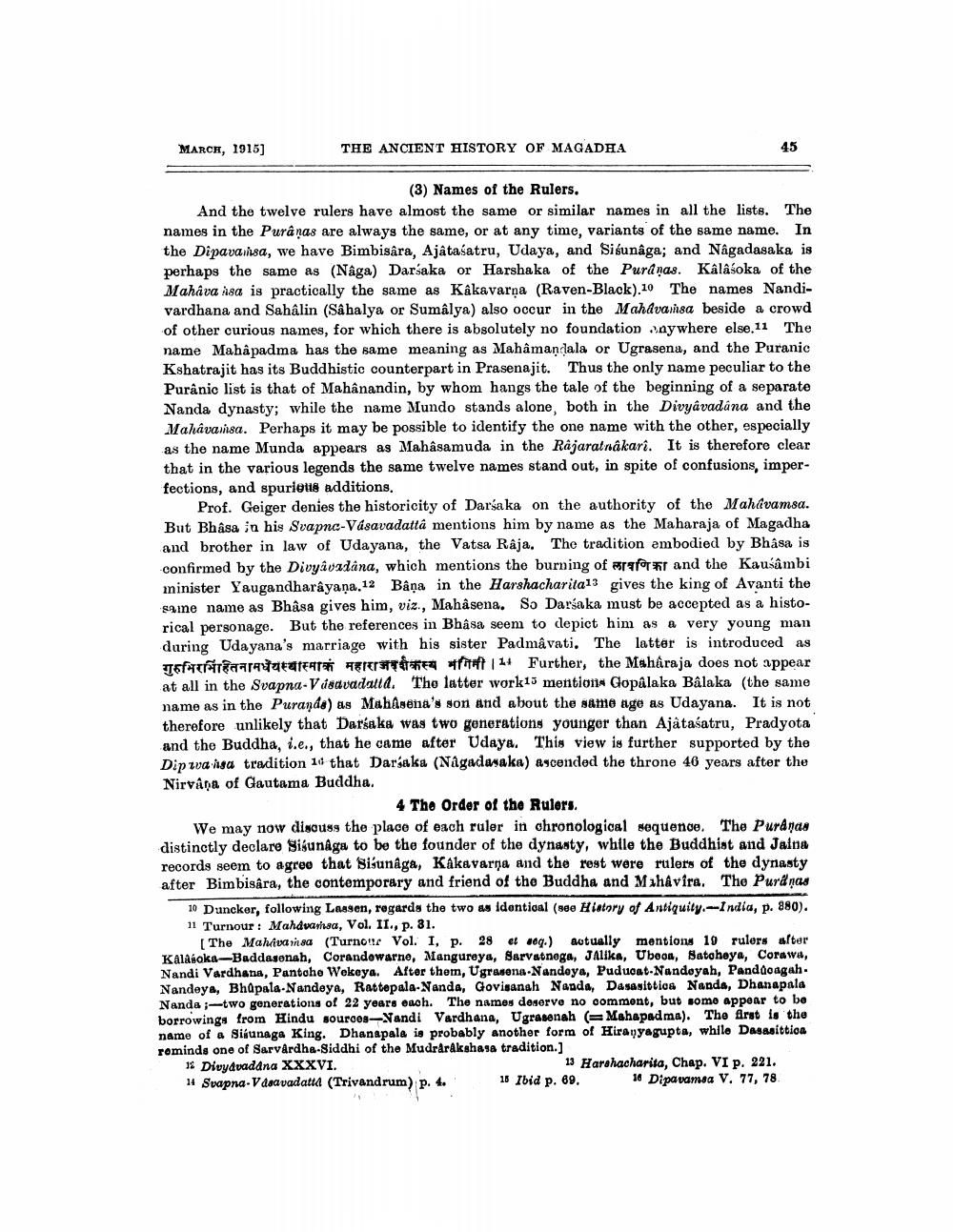________________
MARCH, 1915)
THE ANCIENT HISTORY OF MAGADHA
(3) Names of the Rulers. And the twelve rulers have almost the same or similar names in all the lists. The names in the Purâņas are always the same, or at any time, variants of the same name. In the Dipavainsa, we have Bimbisára, Ajâtaśatru, Udaya, and Sisunâga; and Nagadasaka is perhaps the same as (Naga) Darsaka or Harshaka of the Puranas. Kalafoka of the Mahåva isa is practically the same as Kakavarņa (Raven-Black),20 The names Nandivardhana and Sahâlin (Sabalya or Sumâlya) also occur in the Mahavainsa beside a crowd of other curious names, for which there is absolutely no foundation aywhere else 11 The name Mahapadma has the same meaning as Mahamandala or Ugrasena, and the Puranic Kshatrajit has its Buddhistic counterpart in Prasenajit. Thus the only name peculiar to the Purânic list is that of Mahanandin, by whom hangs the tale of the beginning of a separate Nanda dynasty; while the name Mundo stands alone, both in the Divyavadana and the Mahavainsa. Perhaps it may be possible to identify the one name with the other, especially as the name Munda appears as Mahasamuda in the Rajaratnakari. It is therefore clear that in the various legends the same twelve names stand out, in spite of confusions, imperfections, and spurious additions,
Prof. Geiger denies the historicity of Darsaka on the authority of the Mahavamsa. But Bhasa in his Svapnc-Vasavadatta mentions him by name as the Maharaja of Magadha and brother in law of Udayana, the Vatsa Râja. The tradition embodied by Bhasa is confirmed by the Divyavadana, which mentions the burning of arafork and the Kausâmbi minister Yaugandharayaņa 12 Bana in the Harshacharita13 gives the king of Avanti the same name as Bhâsa gives him, viz., Mahasena. So Darsaka must be accepted as a historical personage. But the references in Bhasa seem to depict him as a very young man during Udayana's marriage with his sister Padmavati. The latter is introduced as 16 Baratara herra fuff 14 Further, the Maharaja does not appear at all in the Svapna-Vidavadata. The letter work15 mention Gopalaka Balaka (the same name as in the Puraşda) as Mahasena's son and about the same age as Udayana. It is not therefore unlikely that Darsaka was two generations younger than Ajätaśatru, Pradyota and the Buddha, i.e., that he came after Udays. This view is further supported by the Dipwa isa tradition 10 that Darsaka (Nagadasaka) ascended the throne 46 years after the Nirvana of Gautama Buddha.
4 The Order of the Rulers. We may now discuss the place of each ruler in chronological sequence. The Puranas distinctly declare Sisunaga to be the founder of the dynasty, while the Buddhist and Jaina records seem to agree that Sisunaga, Kakavarra and the rest woro rulers of the dynasty after Bimbisára, the contemporary and friend of the Buddha and Mahavira, The Puranas
10 Duncker, following Laagen, regards the two as identical (se History of Antiquity.--India, p. 880). 11 Turnour: Mahdvarhea, Vol. II, p. 81.
[The Mahavarisa (Turnoc Vol. I, p. 28 et seq.) actually mention 19 rulers after Kalaboka-Baddasonah, Corandowarne, Mangureya, Barvatnoga, Jalka, Uboon, Batoheya, Corawa, Nandi Vardhana, Pantoho Wokeya. After them, Ugrana.Nandoya, Puduoat.Nandoyah, Panddoagah. Nandeya, BhQpala-Nandoya, Rattopala Nanda, Govisanah Nanda, Dasanittion Nanda, Dhanapala Nanda ;-two generations of 22 years each. The names deserve no comment, but some appear to be borrowings from Hindu sourcos-Nandi Vardhana, Ugrasenah (Mahapadma). The first is the name of a sijunaga King. Dhanapala is probably another form of Hirayyagupta, while Dagasittioa rominds one of Sarvardha-Siddhi of the Mudrarakshasa tradition.] 11 Divydvadana XXXVI.
13 Harshacharita, Chap. VI p. 221. 14 Swapna-Vasavadatta (Trivandrum) p. 4. 15 Ibid p. 69. 18 Dipavamsa V. 77, 78




